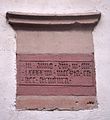Glandern Abbey
The Glandern Abbey was a Benedictine monastery in Longeville-lès-Saint-Avold ( Lorraine ), which u. a. Had remote ownership in what is now Rhineland-Palatinate and Saarland . There are significant remains of the abbey itself and its own churches in the Leininger Land .
history
The convent appears in historical sources under different names, such as the Abbey of Glandern , St. Martinus ad Glandres , Saint-Martin-des-Glandières , Sankt Martin im Eichengrund , St. Martin Longeville or derived from the place Longeville, Lungenfeld or Lubeln . All these names mean the same monastery, in what is now Longeville-lès-Saint-Avold . The name Glandern is derived from the Latin word glandes for acorns , which also appear in the monastery coat of arms . The parish of Longeville has adopted the acorns in their coat of arms; Patron was St. Martin of Tours .
The Benedictine abbey was very old. Duke Bodogisel of Aquitaine , husband of St. Oda of Amay (also Chrodoara d´Amay), is said to have been its founder and abbot of the monastery in 587. Augustin Calmet also cites several uncertain traditions in 1745, according to which St. Arnual founded the abbey, then that St. Dignus, Bodagislus and Undonis were the founders around 580/90 and died or buried there, as well as that St. Fridolin († 538) founded the monastery.
The abbey was first mentioned in a document in 875, in connection with goods in the Palatinate town of Grünstadt . A related document from 836 is forged. On November 21, 875, King Ludwig the German in Metz, on the advice of Archbishop Bertulf von Trier, returned the "villa Grinstadt" in Wormsgau to the monastery of St. Martin and the blessed confessor Undo . The Grünstadt property became the provost's office . Like the mother monastery in Glandern, it had a church consecrated to St. Martin and formed one of three germ cells of today's Grünstadt. This multiple redesigned Martinskirche still exists in the same place today. The estate was later called “Lungenfelder Hof” in Grünstadt and was transferred to the Counts of Leiningen as a pledge or in 1735 , who converted it into a country palace , the “Unterhof Palace” to the west of the aforementioned Martinskirche. The first documentary mention of the Glandern monastery and the place Grünstadt was made in the same document in 875.
The ownership of the still preserved church of St. Martin in nearby Battenberg , whose patronage rights were transferred to the Worms cathedral chapter in 1231, is probably similarly old .
In 1212, Bishop Luitpold von Worms confirmed in a document that the abbot of St. Martin zu Glandern was allowed to use the slopes of the churches in Grünstadt and Mertesheim for the benefit of his monastery. Mertesheim, with its old Martinskirche (today St. Valentin), belonged to the early remote ownership of the Lorraine Abbey.
The Glandern Abbey still had ownership rights in Ittersdorf in Saarland and in Ensheim ; She sold the latter to the Wadgassen monastery in 1538 .
The consecration of a new monastery church in Glandern is documented for the year 1204, a hospital was opened in 1220, and the abbey church was renewed in 1427. In 1552 troops of Margrave Albrecht of Prussia devastated the abbey, in 1635 the Swedes. In 1672, during the Dutch-French War , further destruction took place. In 1685 King Louis XIV had the monastery restored. As a result of the French Revolution , the Convention was dissolved in 1791; the monastery church was demolished in 1793. The mighty abbey building has been preserved, the oldest parts of which date from the early 15th century. At first it became a distillery for potato schnapps, from which the Lubelner got their Uzname “the Grumbiren Pitscher”, then it went into private ownership. In 1905 the diocese of Metz acquired it and set up a Franciscan convent in it . Later a new chapel with a crypt was built on the site of the old monastery church, partly from its historical building material. Today the facility serves as a spa and recreation home.
literature
- Augustin Calmet : Histoire de Lorraine , Volume 1, Nancy 1745, Col. 365-366. Digital scan
- Ludwig Blankenheim: From Grünstadt's bygone days , Rheinpfalz Verlag, Ludwigshafen 1955,
- Alois Gerlich : The Metz property in Wormsgau , In: Leaves for Palatinate Church History and Religious Folklore , Volume 18, 1951, pp. 97–115
gallery
Longeville-lès-Saint-Avold , plaque with data on the history of the monastery
Today's Martinskirche Grünstadt , on the site of the old Martinskirche of the Glandern Monastery
Grünstadt , Martinskirche, edification inscription from the Glander period (1494)
Sacrament niche in the old Martinskirche in Grünstadt; today as Spolie in Boßweiler
Catholic Church of St. Valentin (formerly St. Martin), Mertesheim , around 1500
Martinskirche Battenberg (Palatinate) , around 1200
Web links
Individual evidence
- ↑ Oda von Amay in the portal "Ecumenical Saint Lexicon"
- ↑ Calmet 1745, Col. 365
- ↑ a b Calmet 1745, col. 366
- ^ Regest of the real document from 875
- ^ Regest of the forged document from 836
- ^ Paul Kehr (ed.): Diplomata 8: The documents of Ludwig the German, Karlmann and Ludwig the Younger (Ludowici Germanici, Karlomanni, Ludowici Iunioris Diplomata). Berlin 1934, pp. 231–232 ( Monumenta Germaniae Historica , digitized version )
- ^ Walter Lampert: 1100 Years of Grünstadt , Grünstadt City Administration, 1975, pp. 34–39 and 317–319
- ↑ Website about the Battenberg Church
- ↑ Website on the history of Mertesheim ( Memento of the original from January 3, 2014 in the Internet Archive ) Info: The archive link was inserted automatically and has not yet been checked. Please check the original and archive link according to the instructions and then remove this notice.
- ^ Website about Ensheim, with mention of the Glandern Abbey
Coordinates: 49 ° 6 ′ 59 ″ N , 6 ° 37 ′ 58 ″ E
















